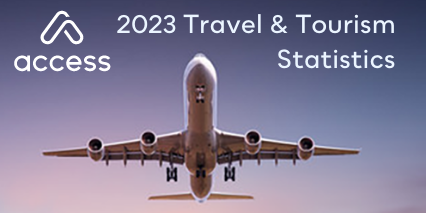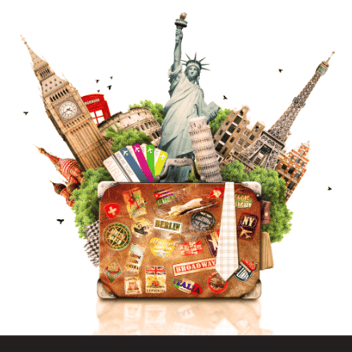2021 Customer Engagement & Loyalty Statistics
Indeed, we have many articles that dive into these findings on our loyalty blog and employee benefits blog.
This page, however, is for the raw data. For your convenience, we've compiled dozens of loyalty statistics published in 2021 - from how many people are active in loyalty programs to what they're looking to get out of them and how they'd like to be communicated with.
- 2021 Customer Engagement & Loyalty Statistics
- 2021 Loyalty Program / Loyalty Marketing Statistics
- 2021 Retail Loyalty Statistics
- 2021 Mobile/Online Marketing Statistics
- 2021 Restaurant Loyalty Statistics
- 2021 B2B Loyalty Statistics
- 2021 Travel Loyalty Statistics
- 2021 Other Loyalty Statistics
2021 Customer Engagement & Loyalty Stats
- 75% of consumers are more likely to purchase from brands whose apps allow them to transact quickly (Google)
- Businesses report that 20% to 40% of their live customer service interactions could easily be resolved using existing self-service functionalities (Gartner)
- 70% of customers who contact customer service attempt self-service during their resolution journey, but only 9% are wholly contained within self-service (Gartner)
- An estimated 80% of customers in the developed world call phone-based interactive voice response (IVR) using a smartphone (Gartner)
- By 2025, it’s predicted that proactive outbound interactions will overtake reactive inbound interactions (Gartner)
- By 2025, it’s predicted that 40% of customer service organizations will become profit centers by becoming de facto leaders in digital customer engagement (Gartner)
- By 2025, it’s predicted that 80% of customer service organizations will have abandoned native mobile apps in favor of messaging on third-party social platforms (Gartner)
- The probability of selling to an existing customer is 60-70%, while the probability of selling to a new prospect is 5% to 20% (Markinblog)
- The probability of selling to an existing customer is 3x to 35x higher than selling to a new one (Markinblog)
- 44% of companies have a greater focus on acquisition vs. 16% that focus on retention (Markinblog)
- 65% of a company’s business comes from existing customers (Markinblog)
- For most industries, the average customer retention rate is below 20% (MixPanel)
- Loyal customers spend 67% more than new customers (Markinblog)
- Only 40% of companies have an equal focus on acquisition and retention (Markinblog)
- 89% of businesses see customer experience as a key factor in driving customer loyalty and retention (Markinblog)
- When dealing with customer service: 44% of customers value “get it done right” (effectiveness, accuracy, security), 39% value “make it painless” (success with a live agent, trust in method, speed, ease of use, convenience), 17% value “on my terms” (friendliness, personalization, creativity, channel choice) (Aspect)
- 75% of consumers consider voice calls to be an effective form of customer service, 66% for chat, 58% for email and only 45% for messaging apps like Facebook Messenger (Aspect)
- 46% of consumers say that the choice to interact using their own contact method of choice to be the most important part of personalized customer service, while 27% said it’s anticipating needs/requests, 15% said it’s knowing customer names and history and 12% said it’s sending targeted/relevant offers (Aspect)
- Preference for voice call customer service rebounded by 10% in 2020 to be preferred by 43% of consumers , compared to 34%of customers in 2019 (Aspect)
- In 2020, the most preferred method of contacting customer service was via voice call (43%), followed by chat (22%), email (14%), text (8%) and messaging app (7%) (Aspect)
- In 2020, 40% of consumers reported having ceased doing business with an organization because of poor customer service, this is down 13% from 2017 (Aspect)
- 25% of customers have stopped doing business with a cable company because of poor customer service, 24% with a retail location, 22% with a financial institution, 21% with an online retailer, 20% with a wireless company and 17% with a travel company (Aspect)
- 46% of consumers have started doing more business with an online retailer because of exceptional customer service, 31% with an in-store retailer, 16% with a travel company (Aspect)
- 26% of people are willing to pay 5% more for great customer service (Aspect)
- 27% of people are willing to pay 10% more for exceptional customer service (Aspect)
- 72% of consumers are likely to rate or review a customer service experience, down 8% from 2018 (Aspect)
- Consumers are 2x more likely to rate or review a good customer service experience over a bad one (Aspect)
- When asked how important each of these marketing reasons were to them, consumers rated : alerts of new services or products at 44%, businesses checking in on them at 40%, stories about the business or organization they might find interesting at 33%, requests to participate in marketing research 32% and fundraising requests at 28% (Aspect)
- 41% of consumers prefer proactive contact from businesses to come in the form of email, 24% via voice call, and 15% via SMS/text (Aspect)
- 72% of consumers choose a live agent when contacting customer service, 28% choose self service
- (Aspect)
- 77% of consumers will choose a live agent over self-service to help with complex customer service tasks compared to only 58% when the task is simpler (Aspect)
- 74% of consumers would prefer their customer service experience to be a longer interaction with a happy agent over a slightly faster interaction with an uninterested agent (Aspect)
- 35% of customer service agents working in the field are very satisfied with their job (Aspect)
- Marketing email messages have roughly a 20% open rate while SMS messages have roughly a 98% open rate (Mobile Marketing Watch)
2021 Loyalty Program / Loyalty Marketing Stats
- 68% of consumers agree that their loyalty is more difficult to than ever before (Clarus Commerce)
- 81% of traditional loyalty program members would join a premium loyalty program at their favorite retailer, as long as the benefits were valuable (Clarus Commerce)
- 79% of consumers say they don’t want to accumulate points anymore, but that loyalty programs should provide immediate benefits to maintain their loyalty (Clarus Commerce)
- 90% of consumers would likely choose a retailer where they hold a premium loyalty membership over another retailer offering a lower price (Clarus Commerce)
- 95% of businesses with traditional loyalty programs have discussed launching a premium loyalty program in 2021 (Clarus Commerce)
- 90% of businesses say enhancing or expanding their loyalty programs is a priority in 2021
- 78% of marketing and loyalty professionals anticipate an increase in the number of premium loyalty programs due to COVID-19 (Clarus Commerce)
- 57% of marketing and loyalty professionals report lack of budget, internal resources or IT support as the main reasons for not launching loyalty programs (Clarus Commerce)
- 51% of businesses with premium loyalty programs consider program members to be at least 4x as valuable as non-members (Clarus Commerce)
- 41% of retailers say loyalty program members receive benefits in the first month (Clarus Commerce)
- 65% of retailers say their premium loyalty program members receive benefits at least in the first week, 17% say immediately (Clarus Commerce)
- 86% of retailers who deliver benefits to loyalty program members within the first week report that members shop at least once per week, compared to 63% of retailers who offer benefits within the first month (Clarus Commerce)
- 62% of retailers who deliver loyalty program benefits in the first week of membership experience ROI within the first 6 months, compared to only 21% of retailers who deliver benefits within the first month (Clarus Commerce)
- Only 7% of retailers offer holiday discounts as part of their program while 73% of millennials have joined a loyalty program solely to use discounts during the holiday shopping season (Clarus Commerce)
- 37% of retailers report that competing priorities is the biggest barrier to launching a loyalty program (Clarus Commerce)
- 27% of retailers who offer a loyalty program through a vendor say they have updated their program within the last month compared to only 8% of those who manage loyalty programs in-house (Clarus Commerce)
- 44% of retailers who use a vendor report loyalty members shop with them at least one every few days, compared to 30% of retailers who manage their loyalty program in-house (Clarus Commerce)
- 51% of retailers who use a loyalty program vendor report ROI within the first 6 months, compared to 41% of retailers who manage their loyalty program in-house (Clarus Commerce)
- Consumers are motivated to join a premium loyalty program by these perks: free shipping (66%), instant discounts (60%), surprise rewards (45%), holiday discounts (38%) and exclusive deals (35%) (Clarus Commerce)
- Only 22% of retailers who don’t offer instant discounts as a member benefit would like to in the future, while 60% of consumers report instant discounts would motivate them to join a premium loyalty program (Clarus Commerce)
- 58% of retailers with premium loyalty programs think cost is the main deterrent to customers joining (Clarus Commerce)
- 70% of consumers who aren’t enrolled in a premium loyalty program would join one if their favorite retailer offered it and the benefits were valuable (Clarus Commerce)
- 94% of premium loyalty members shop at that program’s retailer at least once a month, 44% at least every few days (Clarus Commerce)
- 84% of retailers with a premium loyalty program rate the profitability of their program at an 8 out of 10 or above (Clarus Commerce)
- 51% of retailers offer a traditional loyalty program, but no premium loyalty program (Clarus Commerce)
- 73% of premium loyalty members shopped more with their favorite retailers during the pandemic (Clarus Commerce)
- 72% of consumers are more likely to be loyalty to a brand if it offers a personalized experience with additional rewards and benefits (Google)
- 77% of millennial consumers belong to at least one premium loyalty program (Clarus Commerce)
- The percent of consumers who belong to any premium loyalty program: 70% of Gen Z, 77% of millennials, 78% of Gen X, 57% of baby boomers, 74% of consumers over the age of 74 (Clarus Commerce)
- 75% of current premium loyalty members are likely to join an additional premium membership in the next 12 months, 37% will definitely join (Clarus Commerce)
- The top categories for which consumers will pay for a premium loyalty membership include: groceries (58%), clothing & accessories (49%), health & beauty (36%), gas (35%) and travel & hospitality (29%) (Clarus Commerce)
- 88% of premium loyalty members say they are likely to recommend a retailer with valuable premium benefits to a family member or friend (Clarus Commerce)
- In 2021, 67% of premium loyalty members shopped at their favorite retailers at least once a week, up from 58% in 2020 (Clarus Commerce)
- In 2021, 72% of consumers expect to see benefits of a premium loyalty membership within the first week or immediately, compared to 70% in 2020 (Clarus Commerce)
- 40% of consumers belong to 3-4 traditional (free) loyalty programs, 28% belong to 1-2, 20% belong to 5-6, 11% belong to 7+ (Clarus Commerce)
- 81% of consumers say they are likely to pay to join a retailer’s premium loyalty program if they are already a part of its free traditional program, this is up from 67% in 2020 (Clarus Commerce)
- The top 3 reasons for not belonging to a premium loyalty program include: I don’t see the value (44%), It’s too expensive (37%), I would, but the retailers I shop with don’t offer them (30%) (Clarus Commerce)
2021 Mobile / Online Marketing Stats
- 63% of consumers will continue to seek out the best app experiences even once stores reopen after the pandemic (Google)
- 71% of consumers have been purchasing more items online since the pandemic (C+R Research)
- 67% of consumers did more than half of their shopping online during 2020, 14% did all shopping online (C+R Research)
2021 Retail Loyalty Statistics
- 74% of consumers are likely to be loyal to a brand if its app is seamless and easy to use (Google)
Some of the most common types of purchases during the pandemic were clothing (47%) and electronics (44%), close behind were furniture (32%), housewares (23%), cosmetics (20%) and food & drink (20%) (C+R Research)
2021 Restaurant Loyalty Statistics
- Single parents are most likely to have switched to ordering food online rather than onsite since the pandemic began (31%) followed by married parents (25%), single adults (18%) and married couples (12%) (PYMNTS)
- US households spent on average $4520 on digital food orders since the pandemic began, which is 42% of the average household ($10,832) spent on all food orders: $3,034 on food orders placed by phone and $3,278 on food orders placed in person (PYMNTS)
- US households headed by married parents spent an average of $7,792 on digital food orders since the pandemic began (PYMNTS)
- 56% of married couples who order at table-service restaurants do not use loyalty programs because they don’t believe one is available (PYMNTS)
- Single parents are more likely to use restaurant loyalty programs than single people without kids (45% vs. 25%) (PYMNTS)
- 37% of people reported a restaurant loyalty programs would encourage them to spend more on food orders, 40% of parents (PYMNTS)
- 39% of people would spend more on food orders if they could pay online, 44% of married parents (PYMNTS)
- 32% of people would spend more on food orders if they could place them via app, 37% of single parents (PYMNTS)

2021 B2B Loyalty Stats
Check back soon for more statistics added as they are released2021 Travel Stats
- 74% of travelers say they will spend more time choosing a destination this year in 2021 (TripAdvisor)
- 66% of travelers say they will spend more time reading reviews about destinations in 2021 (TripAdvisor)
- 72% of travelers say they will spend more time selecting their accommodations in 2021 (TripAdvisor)
- 70% of travelers say they will spend more time finding things to do at their travel destination in 2021 (TripAdvisor)
- The top factors that influence consumer trust in travel and hospitality businesses include (Morning Consult):
- Is reliable or dependable (85%
- Has good customer service and is responsive to problems (84%)
- Protects customers’ data, privacy and security (83%)
- They have a good safety record (83%)
- They make me feel secure and safe (83%)
- Consistently delivers on what they promise (82%)
- Is a good value for the price (82%)
- Treats customers well , even in tough times (82%)
- They regularly clean and sanitize (81%)
- Has always treated me well (80%)
- The top factors that cause consumers to lose trust in travel and hospitality businesses include (Morning Consult):
- They mistreat passengers’ luggage or personal possessions (86%)
- They have surprise fees (85%)
- You had a bad experience with them or their customer service (85%)
- They do not follow clear safety precautions (85%)
- They had a data breach and your personal information was compromised (85%)
- They are known for not being reliable (84%)
- They do not regularly clean or sanitize (84%)
- 35% of millennials say they have lost trust in a travel or hospitality brand and, as a result, will never use that brand again (Morning Consult)
- Business travelers (61%) and wealthier Americans (57%) say if they trust a brand, they go out of their way to purchase from them. This is higher than the average among adult travelers (44%) (Morning Consult)
- 8 of the 10 most trusted travel and hospitality brands are hotels or resorts, with only one airline on the list (Morning Consult)
- Overall, travelers have a higher net trust in travel brands than they did before the pandemic (Morning Consult)
- 65% of US adults say they would stop purchasing from a travel brand if it did not follow safety precautions, 62% would stop purchasing if a company failed to regularly clean (Morning Consult)
- 47% of US adults say they tend to trust travel and hospitality companies by default, only losing trust if the company does something bad (Morning Consult)
- 32% of US adults say travel and hospitality companies have to earn their trust (Morning Consult)
- 57% of all US adults say trust is a major factor in deciding on travel brands. Trust is even more important to consumers who are members of airline and hotel rewards programs (64%) and business travelers (64%) (Morning Consult)
2021 Other Loyalty Stats
- By 2021, data analytics driven businesses are predicted to take $1.8 billion annually from less informed peers. (Forrester Research)
- 60% of consumers have used a buy now, pay later service and 46% are currently making payments through a buy now, pay later service, even though 66% believe it’s “financially risky” (C+R Research)
- The average debt for buy now, pay later purchases is $883 per person (C+R Research)
- 57% of consumers say they regretted making a purchase through Buy Now, Pay Later because it was too expensive, and 56% have fallen behind making a payment (C+R Research)
- 56% consumers say they prefer Buy Now, Pay Later over using credit cards for purchases, and 38% believe Buy Now, Pay Later services will eventually replace credit cards (C+R Research)
- The top reasons why consumers prefer Buy Now, Pay Later over credit cards for purchases include: It’s easier to make payments (45%), more flexibility (44%), lower interest rates (36%) and easy approval process (33%) (C+R Research)
Got Members/Customers of Your Own?
We at Access Development have spent literal decades finetuning the art of member engagement through membership perks, member benefits, discount programs for associations and the like. Contact us to learn more about the largest private discount program in the nation. Whether it's B1G1 deals at local restaurants, deep discounts on travel bookings or mobile coupons good at thousands of in-store retail locations, Access has the platform you need to add universal, everyday value to any membership.

Topics: millennial statistics, customer loyalty, statistics, loyalty statistics

Written by: Kendra Lusty














Share your Comment.